The "Vegetable Of Kings" Deserves a Royal Sauce!
Did you know asparagus was nicknamed the “Vegetable of Kings?” And when I see what it costs per pound, I tend to understand…back in the day it was probably just kings that could afford it.
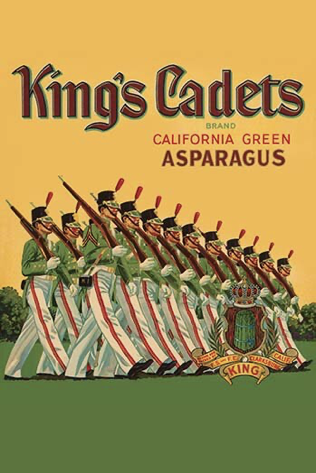
While time has marched on, this impressive vegetable is still expensive. But it’s so darn good that I overlook the cost and splurge once in a while. Although available year-round, spring is the best season for fresh asparagus. Crops are harvested from late February through June, with April being the prime month.
The stalks shoot up from the crown of the plant and grow into fern-like leaves when allowed to develop. However, the edible stalks are harvested strictly by hand before the actual fern leaves develop (which explains why it’s so pricey, right?). It takes three years from the sowing of the seed to the harvest of the first stalks. And talk to any asparagus lover—this is one veggie that’s worth the wait!
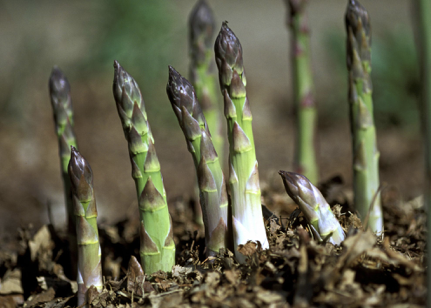
Asparagus is one of the few vegetables that’s grown as a perennial, since the plants have about a 10-year life. Asparagus comes in the following grades: colossal, jumbo, large, standard, and small.
Varieties are interchangeable in recipes, with the only change being in the color of the resultant dish.
Green asparagus: Ranges from pencil-thin to very thick. Most American asparagus is of this variety.
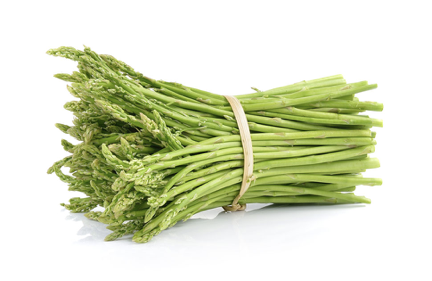
White asparagus: It’s Europe’s preference. These sunlight-deprived stalks are a little milder and more delicate. It is difficult to find white asparagus fresh in the United States, but it’s widely available canned (usually in jars).
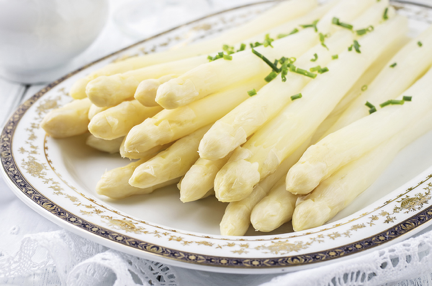
Violet or purple asparagus: This variety is most commonly found in England and Italy. Purple comes with a very thick and substantial stalk.
Wild asparagus: It does grow wild in some areas, particularly in Europe. You'll most likely have to hunt down your own, as it is rarely available fresh in markets, except in Italy and the South of France.
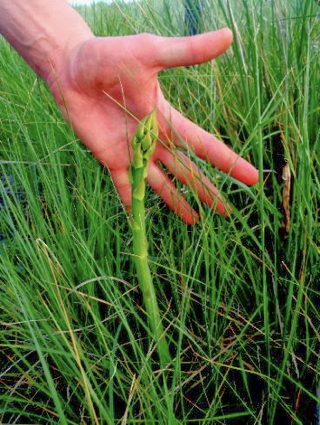
There was an asparagus field behind our subdivision where we raised our kids (Kennewick, WA). Our children liked to peak over our back fence during asparagus season and watch the pickers. I have a hearty respect for, and tender spot in my heart for field workers. Hand-picking crops is back-breaking work.
There was an irrigation ditch that ran alongside the field and we could always find wild (or maybe just stray) asparagus growing in it. So of course, we picked it and enjoyed, enjoyed, enjoyed! The season never lasted long enough.
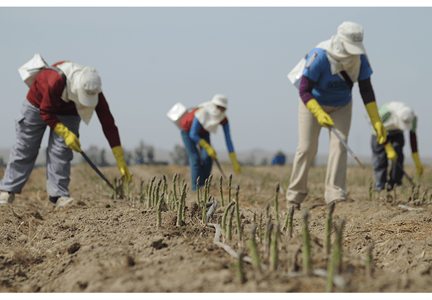
Asparagus has so many health benefits, it should be a definite addition our diet. It’s a great detox vegetable and is also known for its anti-aging properties. Low in calories, it offers digestive support, is a preventer of cancer, and is loaded with vitamins K,
A, B-1, B-2, and C. It also contains impressive amounts of minerals and trace elements: iron, copper, manganese, folate, and tryptophan (right up there with turkey). And of course, its dietary fiber is superb.
When looking for asparagus recipes on the Internet, the first three choices (three different websites) happen to be for either baked or roasted asparagus. As I read these, I was knocked over by how easy this is to prepare. All that’s needed is coarse salt and a good quality olive oil. The asparagus is coated well in the oil, sprinkled generously with the salt, and either baked on HIGH heat (one recipe said 500 degrees) for only around 10 or 12 minutes, to quickly grilling (perhaps 8 or 10 minutes). All recipes suggested carefully watching it and turning often.
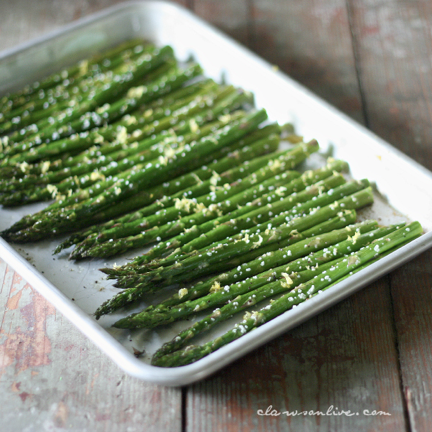
We tried our asparagus this way the other night, and I have to say, I don’t think we’ll ever steam it again. It’s easy to see why so many people recommend preparing it this way. Now that the season’s getting near, let’s plan on indulging. There are so many reasons why we should!
I’ll finish this asparagus tutorial with a recipe that is amazing on roasted asparagus. It’s a nice change from the proverbial hollandaise—truly a royal sauce for the “vegetable of kings.” See what you think:
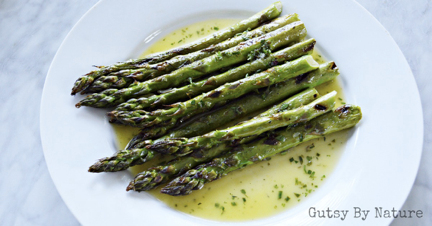
2 teaspoons olive oil
1 teaspoon grated lemon rind
2 tablespoons fresh lemon juice
1/2 teaspoon Dijon style mustard
1/4 teaspoon freshly ground black pepper
1 tablespoon chopped, fresh parsley
Directions:

While time has marched on, this impressive vegetable is still expensive. But it’s so darn good that I overlook the cost and splurge once in a while. Although available year-round, spring is the best season for fresh asparagus. Crops are harvested from late February through June, with April being the prime month.
The stalks shoot up from the crown of the plant and grow into fern-like leaves when allowed to develop. However, the edible stalks are harvested strictly by hand before the actual fern leaves develop (which explains why it’s so pricey, right?). It takes three years from the sowing of the seed to the harvest of the first stalks. And talk to any asparagus lover—this is one veggie that’s worth the wait!

Asparagus is one of the few vegetables that’s grown as a perennial, since the plants have about a 10-year life. Asparagus comes in the following grades: colossal, jumbo, large, standard, and small.
Varieties are interchangeable in recipes, with the only change being in the color of the resultant dish.
Green asparagus: Ranges from pencil-thin to very thick. Most American asparagus is of this variety.

White asparagus: It’s Europe’s preference. These sunlight-deprived stalks are a little milder and more delicate. It is difficult to find white asparagus fresh in the United States, but it’s widely available canned (usually in jars).

Violet or purple asparagus: This variety is most commonly found in England and Italy. Purple comes with a very thick and substantial stalk.
Wild asparagus: It does grow wild in some areas, particularly in Europe. You'll most likely have to hunt down your own, as it is rarely available fresh in markets, except in Italy and the South of France.

There was an asparagus field behind our subdivision where we raised our kids (Kennewick, WA). Our children liked to peak over our back fence during asparagus season and watch the pickers. I have a hearty respect for, and tender spot in my heart for field workers. Hand-picking crops is back-breaking work.
There was an irrigation ditch that ran alongside the field and we could always find wild (or maybe just stray) asparagus growing in it. So of course, we picked it and enjoyed, enjoyed, enjoyed! The season never lasted long enough.

Asparagus has so many health benefits, it should be a definite addition our diet. It’s a great detox vegetable and is also known for its anti-aging properties. Low in calories, it offers digestive support, is a preventer of cancer, and is loaded with vitamins K,
A, B-1, B-2, and C. It also contains impressive amounts of minerals and trace elements: iron, copper, manganese, folate, and tryptophan (right up there with turkey). And of course, its dietary fiber is superb.
When looking for asparagus recipes on the Internet, the first three choices (three different websites) happen to be for either baked or roasted asparagus. As I read these, I was knocked over by how easy this is to prepare. All that’s needed is coarse salt and a good quality olive oil. The asparagus is coated well in the oil, sprinkled generously with the salt, and either baked on HIGH heat (one recipe said 500 degrees) for only around 10 or 12 minutes, to quickly grilling (perhaps 8 or 10 minutes). All recipes suggested carefully watching it and turning often.

We tried our asparagus this way the other night, and I have to say, I don’t think we’ll ever steam it again. It’s easy to see why so many people recommend preparing it this way. Now that the season’s getting near, let’s plan on indulging. There are so many reasons why we should!
I’ll finish this asparagus tutorial with a recipe that is amazing on roasted asparagus. It’s a nice change from the proverbial hollandaise—truly a royal sauce for the “vegetable of kings.” See what you think:

Dijon Lemon Sauce
Ingredients:
2 teaspoons olive oil
1 teaspoon grated lemon rind
2 tablespoons fresh lemon juice
1/2 teaspoon Dijon style mustard
1/4 teaspoon freshly ground black pepper
1 tablespoon chopped, fresh parsley
Directions:
Combine all ingredients in a small bowl, stirring with a whisk. Arrange asparagus on a platter; drizzle sauce over roasted asparagus. Garnish with parsley. Serve immediately.
Recipe formatted with the Cook'n Recipe Software from DVO Enterprises.
Sources:
- www.wayfair.com
- www.thespruce.com
- www.clubdia.com
- www.modernfarmer.com
- www.hungerandthirstforlife.blogspot.com
- www.thepacker.com
- www.abakerswife.com
- www.gutsybynature.com
 Alice Osborne
Alice Osborne
Weekly Newsletter Contributor since 2006
Email the author! alice@dvo.com
